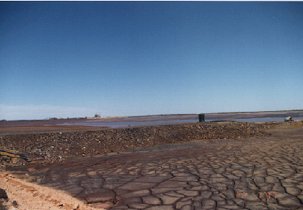TAILINGS - A CRUCIAL BUT UNRESOLVED MATTER
A major concern about nuclear energy is disposal of radioactive waste
material. This applies to the mining and milling stage of nuclear energy
as well as later stages of the fuel cycle. This concern is expressed vividly
by Friends of the Earth Sydney:
No matter how uranium is mined, there will be radioactive contamination
of the environment . . . Uranium tailings constitute the greatest long-term
impact . . . uranium tailings will remain a significant impact for periods
between 300,000 and 760,000 years. (S 40, Part 2, 30)
Uranium tailings contain 80% of the level of radioactivity of
the original ore as a result of the presence of uranium decay products
such as Thorium-234, Thorium-230, and Radium-226. This radioactivity
will be a potential problem requiring containment for hundreds of thousands
of years, though current uranium mill tailings containment arrangements
cover usually no more than 200-500 years. (S 40, Part 2, 32)
The core of the problem of tailings, as FoE Sydney see the matter, is
that "uranium mines have to process vast quantities of ore in order
to be able to produce relatively small quantities of yellowcake"
(ibid.).
The size of the problem posed by tailings may be found in the 1988-89
report of the then Supervising Scientist, Mr R.M. Fry. He observed that
at the end of mining orebodies #1 and 3 at Ranger, as much as 40-45 million
tonnes of tailings will have been produced: "Almost all of the radioactivity
from the original orebodies will be contained in the tailings, and the
half-life of the longest-lived daughter of uranium, Th230, will ensure
that a potential health hazard remains for several hundred thousand years."
The Committee, whilst not necessarily sharing the more pessimistic
forebodings about management of tailings, nonetheless views tailings management
as among the most serious challenges facing uranium miners and, indeed,
the entire nuclear energy industry in the future. It will also continue
to be a major preoccupation for regulators and scientists as well.
There are several considerations relevant to the matter. In the first
instance, and illustrative of the dynamics of improvement in mining generally
and uranium in particular, tailings management and rehabilitation are
now actively part of mining. As the state of mines in Australia's first
phase of uranium mining demonstrates, in the first two decades after the
end of the Second World War rehabilitation was manifestly neglected. Mines,
once they had yielded their product, were abandoned.
The unfinished story of Nabarlek, notwithstanding the scepticism of some
observers, is an illustration of a different philosophy of mining, one
which recognises that it is a temporary form of land use. In both the
planning and the financing of the mine, rehabilitation is part of the
full management of the project. And this means, above all, management
of tailings. The Committee believes that an effective plan for managing
tailings must be a prerequisite for the issue of any licence to mine.
It also underlines the importance of research. Research is integral
to processes of constructive regulation of mining and to minimising the
impact of mining activity upon the environment.
The comparison of Rum Jungle and Nabarlek shows how much progress there
has been in the past three decades. Our conclusion, shared by the entire
Committee with varying degrees of optimism, is that the research endeavour
must be maintained. This has influenced our views on the role of the Supervising
Scientist which forms the subject of the next chapter and our view of
the value of transparency of research whether it is in the hands of governments
or mining companies.

Ranger - Tailings Dam

Olympic Dam Operation - Tailings Storage Facility